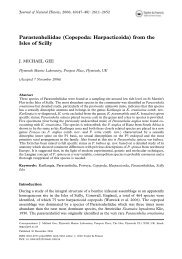An Updated Classification of the Recent Crustacea
An Updated Classification of the Recent Crustacea
An Updated Classification of the Recent Crustacea
You also want an ePaper? Increase the reach of your titles
YUMPU automatically turns print PDFs into web optimized ePapers that Google loves.
CONCLUDING REMARKS<br />
We have thoroughly enjoyed <strong>the</strong> discussions with,<br />
and suggestions from, fellow carcinologists during<br />
<strong>the</strong> compilation and editing <strong>of</strong> this classification.<br />
Doubtless we have pleased and angered some<br />
workers more than o<strong>the</strong>rs in our ‘‘final’’ arrangement.<br />
We have been accused <strong>of</strong> making changes<br />
‘‘simply for <strong>the</strong> sake <strong>of</strong> change,’’ while at <strong>the</strong> same<br />
time we have been accused <strong>of</strong> ‘‘classificatory paralysis’’<br />
in our ‘‘unwillingness to change.’’ The classification<br />
has been criticized as being ‘‘nonphylogenetic,’’<br />
while at <strong>the</strong> same time parts <strong>of</strong> it have been<br />
criticized as relying too heavily on ‘‘recent lines <strong>of</strong><br />
cladistic evidence’’ (for which read molecular systematics).<br />
We accept all such criticisms gladly; <strong>the</strong>y<br />
are <strong>the</strong> signs <strong>of</strong> a growing and developing field <strong>of</strong><br />
study and <strong>of</strong> a field that is <strong>of</strong> passionate interest to<br />
a large number <strong>of</strong> dedicated workers. We are proud<br />
to be your colleagues.<br />
It is our sincere hope that <strong>the</strong> classification that<br />
follows is used primarily as a starting point for future<br />
research. By comparing <strong>the</strong> new classification<br />
with that <strong>of</strong> Bowman and Abele and seeing where<br />
changes have, and have not, occurred, and by reading<br />
<strong>the</strong> various dissenting opinions that follow (in<br />
Appendix I), we hope that <strong>the</strong> weaknesses inherent<br />
in this classification will be more readily spotted.<br />
We fur<strong>the</strong>r hope that knowledge <strong>of</strong> <strong>the</strong>se weaknesses<br />
will in turn lead to fur<strong>the</strong>r work on <strong>the</strong> <strong>Crustacea</strong>,<br />
<strong>the</strong> planet’s most morphologically diverse—<br />
and to us, <strong>the</strong> most interesting—group <strong>of</strong> organisms.<br />
Contributions in Science, Number 39 Concluding Remarks 57











